Desa CGN20, RN30D, CGN20L User Manual
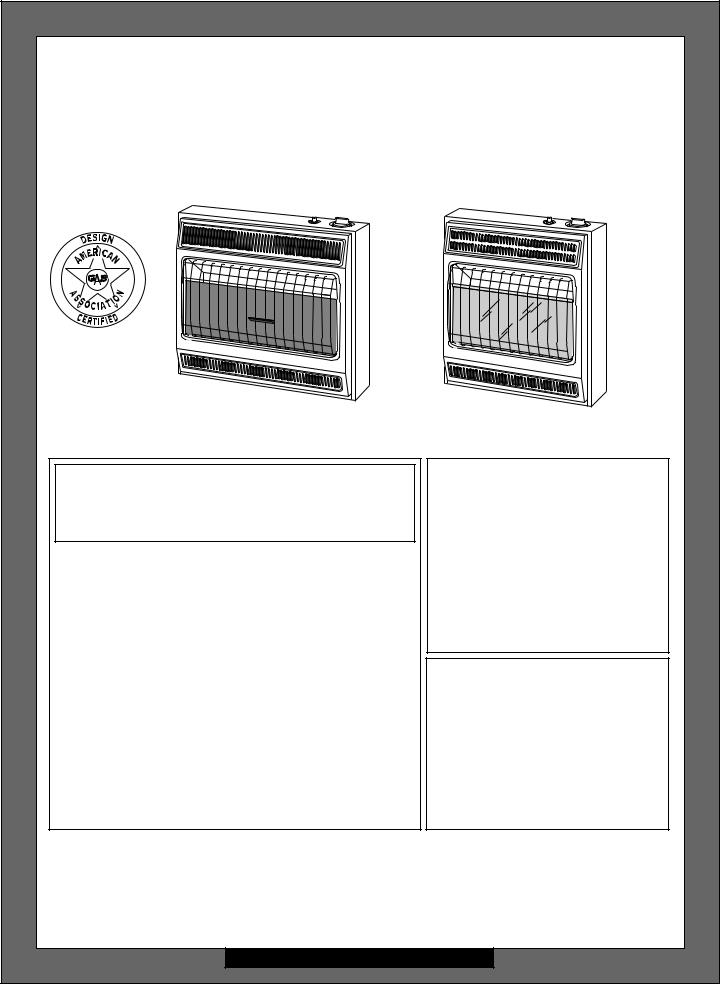
BLUE-FLAME VENT-FREE NATURAL GAS HEATER
OWNER’S OPERATION AND INSTALLATION MANUAL
RN30D |
CGN20 |
CGN20L |
®
Models: CGN20, CGN20L, and RN30D
WARNING: If the information in this manual is not followed exactly, a fire or explosion may result causing property damage, personal injury, or loss of life.
—Do not store or use gasoline or other flammable vapors and liquids in the vicinity of this or any other appliance.
—WHAT TO DO IF YOU SMELL GAS
•Do not try to light any appliance.
•Do not touch any electrical switch; do not use any phone in your building.
•Immediately call your gas supplier from a neighbor’s phone. Follow the gas supplier’s instructions.
•If you cannot reach your gas supplier, call the fire department.
—Installation and service must be performed by a qualified installer, service agency, or the gas supplier.
WARNING: Improper installation, adjustment, alteration, service, or maintenance can cause injury or property damage. Refer to this manual for correct installation and operational procedures. For assistance or additional information consult a qualified installer, service agency, or the gas supplier.
WARNING: This is an unvented gas-fired heater. It uses air (oxygen) from the room in which it is installed. Provisions for adequate combustion and ventilation air must be provided. Refer to Air for Combustion and Ventilation section on page 3 of this manual.
This appliance may be installed in an aftermarket* manufactured (mobile) home, where not prohibited by state or local codes.
*Aftermarket: Completion of sale, not for purpose of resale, from the manufacturer. (I.E. Installation of this
product is permitted after the manufactured (mobile) home is sited)
This appliance is only for use with the type of gas indicated on the rating plate. This appliance is not convertible for use with other gases.
Save this manual for future reference.

BLUE-FLAME CGN20, CGN20L AND RN30D
VENT-FREE NATURAL GAS HEATERS
SAFETY
INFORMATION
 WARNINGS
WARNINGS
IMPORTANT: Read this Owner’s Manual carefully and completely before trying to assemble, operate, or service this heater. Improper use of this heater can cause serious injury or death from burns, fire, explosion, electrical shock, and carbon monoxide poisoning.
 DANGER: Carbon monoxide poisoning may lead to death!
DANGER: Carbon monoxide poisoning may lead to death!
Carbon Monoxide Poisoning: Early signs of carbon monoxide poisoning resemble the flu, with headaches, dizziness, or nausea. If you have these signs, the heater may not be working properly. Get fresh air at once! Have heater serviced. Some people are more affected by carbon monoxide than others. These include pregnant women, persons with heart or lung disease or anemia, those under the influence of alcohol, and those at high altitudes.
Natural Gas: Natural gas is odorless. An odor-making agent is added to natural gas. The odor helps you detect a natural gas leak. However, the odor added to natural gas can fade. Natural gas may be present even though no odor exists.
Make certain you read and understand all Warnings. Keep this manual for reference. It is your guide to safe and proper operation of this heater.
 WARNING: Any change to this heater or its controls can be dangerous.
WARNING: Any change to this heater or its controls can be dangerous.
1.This appliance is only for use with the type of gas indicated on the rating plate. This appliance is not convertible for use with other gases.
2.If you smell gas
•shut off gas supply
•do not try to light any appliance
•do not touch any electrical switch; do not use any phone in your building
•immediately call your gas supplier from a neighbor’s phone. Follow the gas supplier’s instructions
•if you cannot reach your gas supplier, call the fire department
3.This heater shall not be installed in a bedroom or bathroom.
4.Never install the heater
•in a recreational vehicle
•where curtains, furniture, clothing, or other flammable objects are less than 36 inches from the front, top, or sides of the heater
•as a fireplace insert
•in high traffic areas
•in windy or drafty areas
5.This heater needs fresh, outside air ventilation to run properly. This heater has an oxygen depletion sensor (ODS) pilot light safety system. The ODS shuts down the heater if not enough fresh air is available. See Air for Combustion and Ventilation, pages 3 through 5.
6.Keep all air openings in front and bottom of heater clear and free of debris. This will insure enough air for proper combustion.
7.If heater shuts off, do not relight until you provide fresh, outside air. If heater keeps shutting off, have it serviced.
8.Do not run heater
•where flammable liquids or vapors are used or stored
•under dusty conditions
9.Never place any objects on the heater.
10.Surface of heater becomes very hot when running heater. Keep children and adults away from hot surface to avoid burns or clothing ignition. Heater will remain hot for a time after shutdown. Allow surface to cool before touching.
11.Carefully supervise young children when they are in same room with heater.
12.Make sure grill guard is in place before running heater.
13.Do not use heater if any part has been under water. Immediately call a qualified service technician to inspect the room heater and to replace any part of the control system and any gas control which has been under water.
14.Turn off heater and let cool before servicing. Only a qualified service person should service and repair heater.
15.Operating heater above elevations of 4,500 feet could cause pilot outage.
LOCAL CODES
Install and use heater with care. Follow all local codes. In the absence of local codes, use the latest edition of National Fuel Gas Code ANSI Z223.1, also known as NFPA 54*.
*Available from:
American National Standards Institute, Inc.
1430 Broadway
New York, NY 10018
National Fire Protection Association, Inc.
Batterymarch Park
Quincy, MA 02269
UNPACKING
1.Remove heater from carton.
2.Remove all protective packaging applied to heater for shipment.
3.Check heater for any shipping damage. If heater is damaged, promptly inform dealer where you bought heater.
PRODUCT
FEATURES
Safety Device
This heater has a pilot with an Oxygen Depletion Sensor Shutoff System (ODS). The ODS/pilot is a required feature for ventfree heaters. The ODS/pilot shuts off the heater if there is not enough fresh air.
Piezo Ignition System
This heater has a piezo ignitor. This system requires no matches, batteries, or other sources to light heater.
2 |
103568 |
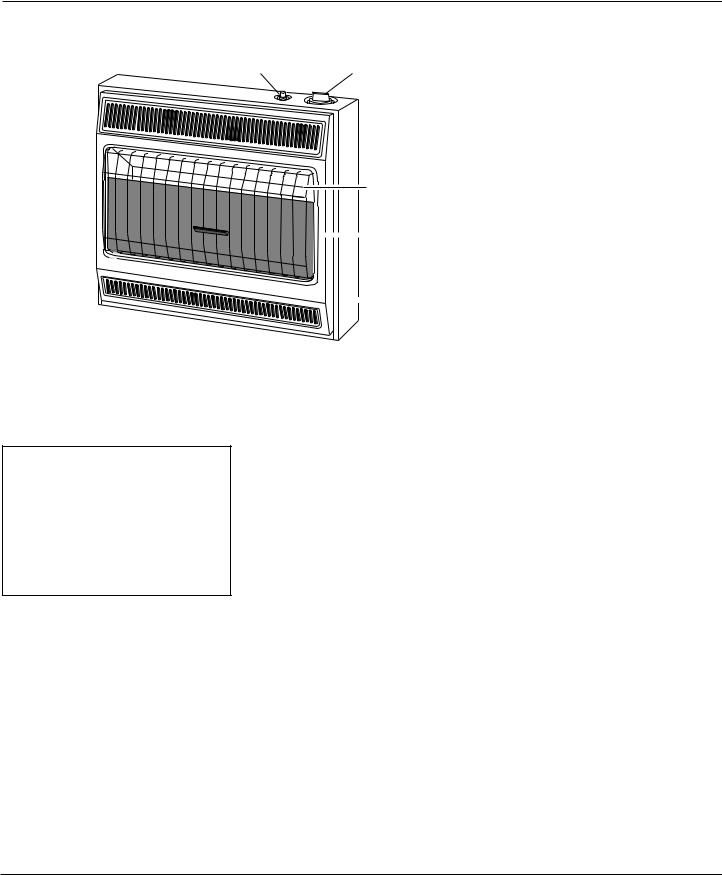
OWNER’S MANUAL
PRODUCT
IDENTIFICATION
Ignitor Button |
Control Knob |
Grill
Guard
Heat Shield
 (RN30D) or Glass
(RN30D) or Glass
Panel (CGN20[L])
Front 
Panel
 Heater
Heater
Cabinet
Figure 1 - Vent-Free Natural Gas Heater
AIR FOR COMBUSTION
AND VENTILATION
 WARNING: This heater shall not be installed in a confined space unless provisions are provided for adequate combustion and ventilation air. Read the following instructions to insure proper fresh air for this and other fuel-burning appliances in your home.
WARNING: This heater shall not be installed in a confined space unless provisions are provided for adequate combustion and ventilation air. Read the following instructions to insure proper fresh air for this and other fuel-burning appliances in your home.
Today’s homes are built more energy efficient than ever. New materials, increased insulation, and new construction methods help reduce heat loss in homes. Home owners weather strip and caulk around windows and doors to keep the cold air out and the warm air in. During heating months, home owners want their homes as airtight as possible.
While it is good to make your home energy efficient, your home needs to breathe. Fresh air must enter your home. All fuel-burning appliances need fresh air for proper combustion and ventilation.
Exhaust fans, fireplaces, clothes dryers, and fuel burning appliances draw air from the house to operate. You must provide adequate fresh air for these appliances. This will insure proper venting of vented fuel-burning appliances.
PROVIDING ADEQUATE VENTILATION
The following is excerpts from National Fuel Gas Code. NFPA 54/ANSI Z223.1, Section 5.3, Air for Combustion and Ventilation.
All spaces in homes fall into one of the three following ventilation classifications:
1. Unusually Tight Construction; 2. Unconfined Space; 3. Confined Space.
The information on pages 3 through 5 will help you classify your space and provide adequate ventilation.
Unusually Tight Construction
The air that leaks around doors and windows may provide enough fresh air for combustion and ventilation. However, in buildings of unusually tight construction, you must provide additional fresh air.
Unusually tight construction is defined as construction where:
a.walls and ceilings exposed to the outside atmosphere have a continuous water vapor retarder with a rating of one perm (6x10-11kg per pa-sec-m2) or less with openings gasketed or sealed and
b.weather stripping has been added on openable windows and doors and
c.caulking or sealants are applied to areas such as joints around window and door frames, between sole plates and floors, between wall-ceiling joints, between wall panels, at penetrations for plumbing, electrical, and gas lines, and at other openings.
If your home meets all of the three criteria above, you must provide additional fresh air. See Ventilation Air From Outdoors, page 5.
If your home does not meet all of the three criteria above, proceed to page 4.
Confined and Unconfined Space
The National Fuel Gas Code (ANSIZ2123.1, 1992 Section 5.3) defines a confined space as a space whose volume is less than 50 cubic feet per 1,000 Btu per hour (4.8 m3 per kw) of the aggregate input rating of all appliances installed in that space and an unconfining space as a space whose volume is not less than 50 cubic feet per 1,000 Btu per hour (4.8 m3 per kw) of the aggregate input rating of all appliances installed in that space. Rooms communicating directly with the space in which the appliances are installed*, through openings not furnished with doors, are considered a part of the unconfined space.
* Adjoining rooms are communicating only if there are doorless passageways or ventilation grills between them.
Continued
103568 |
3 |

BLUE-FLAME CGN20, CGN20L AND RN30D
VENT-FREE NATURAL GAS HEATERS
AIR FOR COMBUSTION AND VENTILATION
Continued
DETERMINING AIR FLOW FOR HEATER LOCATION
Determining if You Have a Confined or Unconfined Space
Use this worksheet to determine if you have a confined or unconfined space.
Space: Includes the room in which you will install heater plus any adjoining rooms with doorless
passageways or ventilation grills between the rooms.
1.Determine the volume of the space (length x width x height).
Length x Width x Height =
__________ cu. ft. (volume of space)
Example: Space size 20 ft. (length) x 16 ft. (width) x 8 ft. (ceiling height) = 2560 cu. ft. (volume of space)
If additional ventilation to adjoining room is supplied with grills or openings, add the volume of these rooms to the total volume of the space.
2.Divide the space volume by 50 cubic feet to determine the maximum Btu/Hr the space can support.
_____ (volume of space) ÷ 50 cu. ft. = (Maximum Btu/Hr the space can support)
Example: 2560 cu. ft. (volume of space) ÷ 50 cu. ft. = 51.2 or 51,200 (maximum Btu/Hr the space can support)
3.Add the Btu/Hr of all fuel burning appliances in the space.
Vent-free heater ________ Btu/Hr Gas water heater* ______ Btu/Hr Gas furnace ___________ Btu/Hr Vented gas heater ______ Btu/Hr
Gas fireplace logs ______ Btu/Hr Other gas appliances*+ __ Btu/Hr Total = __ Btu/Hr
Example: |
|
|
Gas water heater |
|
40,000 Btu/Hr |
Vent-free heater |
+ |
20,000 Btu/Hr |
|
= |
|
Total |
60,000 Btu/Hr |
* Do not include direct-vent gas appliances. Direct-vent draws combustion air from the outdoors and vents to the outdoors.
4.Compare the maximum Btu/Hr the space can support with the actual amount of Btu/Hr used.
__________ Btu/Hr (maximum the space can support)
__________ Btu/Hr (actual amount of Btu/Hr used)
Example:
51,200 Btu/Hr (maximum the space can support)
60,000 Btu/Hr (actual amount of Btu/Hr used)
The space in the above example is a confined space because the actual Btu/Hr used is more than the maximum Btu/Hr the space can support. You must provide additional fresh air. Your options are as follows:
A.Rework worksheet, adding the space of an adjoining room. If the extra space provides an unconfined space, remove door to adjoining room or add ventilation grills between rooms. See Ventilation Air From Inside Building.
B.Vent room directly to the outdoors. See
Ventilation Air From Outdoors, page 5.
C.Install a lower Btu/Hr heater, if lower Btu/Hr size makes room unconfined.
If the actual Btu/Hr used is less than the maximum Btu/Hr the space can support, the space is an unconfined space. You will need no additional fresh air ventilation.
 WARNING: If the area in which the heater may be operated is smaller than that defined as an unconfined space, provide adequate combustion and ventilation air by one of the methods described in the National Fuel Gas Code, ANSI Z223.1, 1992, Section 5.3 or applicable local codes.
WARNING: If the area in which the heater may be operated is smaller than that defined as an unconfined space, provide adequate combustion and ventilation air by one of the methods described in the National Fuel Gas Code, ANSI Z223.1, 1992, Section 5.3 or applicable local codes.
VENTILATION AIR
Ventilation Air From Inside
Building
This fresh air would come from an adjoining unconfined space. When ventilating to an adjoining unconfined space, you must provide two permanent openings: one within 12" of the ceiling and one within 12" of the floor on the wall connecting the two spaces (see options 1 and 2, Figure 2, page 5). You can also remove door into adjoining room (see option 3, Figure 2, page 5). Follow the
National Fuel Gas Code NFPA 54/ANSI Z223.1, Section 5.3, Air for Combustion and Ventilation for required size of ventilation grills or ducts.
 WARNING: Rework worksheet, adding the space of the adjoining unconfined space. The combined spaces must have enough fresh air to supply all appliances in both spaces.
WARNING: Rework worksheet, adding the space of the adjoining unconfined space. The combined spaces must have enough fresh air to supply all appliances in both spaces.
4 |
103568 |
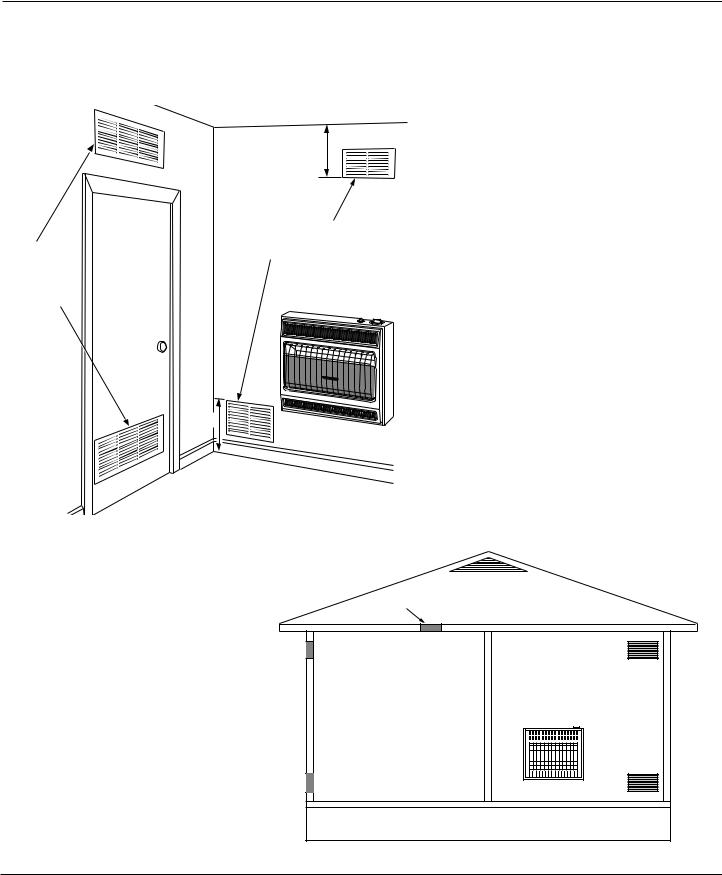
OWNER’S MANUAL
AIR FOR COMBUSTION
AND VENTILATION
Continued
12"
|
Ventilation Grills |
Ventilation |
Into Adjoining Room, |
Option 2 |
|
Grills |
Or |
into Adjoining |
Remove |
Room, |
Door into |
Option 1 |
Adjoining |
|
Room, |
|
Option 3 |
12"
Figure 2 - Ventilation Air from Inside Building
Ventilation Air From Outdoors
Provide extra fresh air by using ventilation grills or ducts. You must provide two permanent openings: one within 12" of the ceiling and one within 12" of the floor. Connect these items directly to the outdoors or spaces open to the outdoors. These spaces include attics and crawl spaces. Follow the
National Fuel Gas Code NFPA 54/ANSI Z223.1, Section 5.3, Air for Combustion and Ventilation for required size of ventilation grills or ducts.
IMPORTANT: Do not provide openings for inlet or outlet air into attic if attic has a thermostat-controlled power vent. Heated air entering the attic will activate the power vent.
Ventilated
Outlet Attic
Air
Outlet 

Air
To Attic
To
Crawl
Space
Inlet
Air
|
|
Inlet Air |
|
Ventilated |
|
|
|
|
|
|
Crawl Space |
|
|
|
|
|
|
|
|
Figure 3 - Ventilation Air from Outdoors
103568 |
5 |
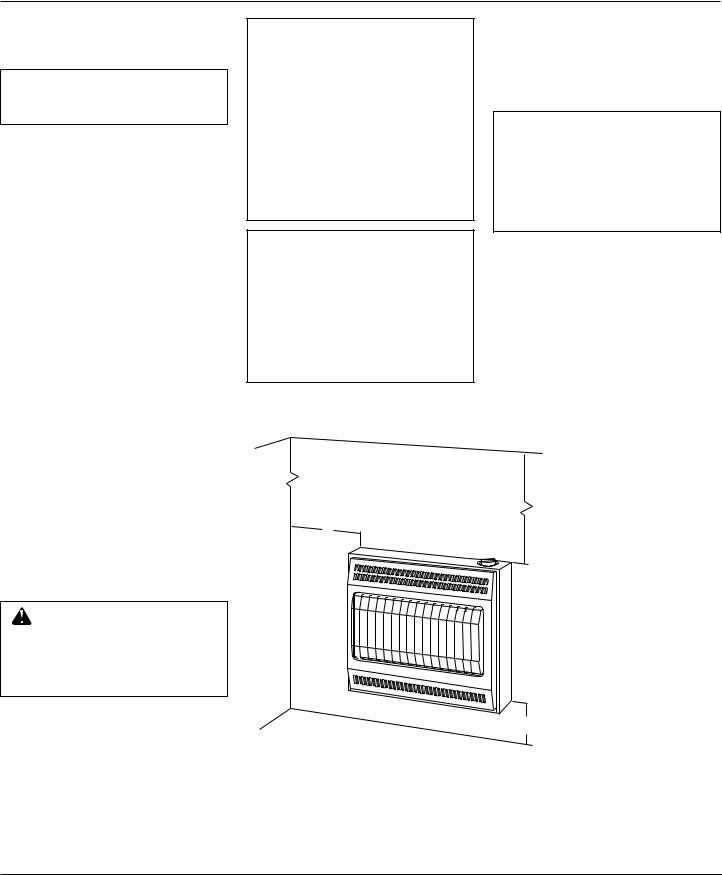
BLUE-FLAME CGN20, CGN20L AND RN30D
VENT-FREE NATURAL GAS HEATERS
INSTALLING TO WALL
NOTICE: A qualified service person must install heater. Follow all local codes.
CHECK GAS TYPE
Use only natural gas. If your gas supply is not natural, do not install heater. Call dealer where you bought heater for proper type heater.
INSTALLATION ITEMS
Before installing heater, make sure you have the items listed below:
•piping (check local codes)
•sealant (resistant to propane/LP gas)
•manual shutoff valve *
•ground joint union
•test gauge connection * (see Figure 12, page 8)
•sediment trap
•tee joint
•pipe wrench
* An A.G.A. design-certified manual shutoff valve with 1/8" NPT tap is an acceptable alternative to test gauge connection. Purchase the optional A.G.A. design-certified manual shutoff valve from your dealer. See
Accessories, page 14.
 WARNING:
WARNING:
Never install the heater
•in a bedroom or bathroom
•in a recreational vehicle
•where curtains, furniture, clothing, or other flammable objects are less than 36 inches from the front, top, or sides of the heater
•as a fireplace insert
•in high traffic areas
•in windy or drafty areas
 CAUTION: This heater creates warm air currents. These currents move heat to wall surfaces next to heater. Installing heater next to vinyl or cloth wall coverings or operating heater where impurities in the air (such as tobacco smoke) exist, may discolor walls.
CAUTION: This heater creates warm air currents. These currents move heat to wall surfaces next to heater. Installing heater next to vinyl or cloth wall coverings or operating heater where impurities in the air (such as tobacco smoke) exist, may discolor walls.
CEILING
6" Minimum from Sides of Heater
IMPORTANT: Vent-free heaters add moisture to the air. Although this is beneficial, installing heater in rooms without enough ventilation air may cause mildew to form from too much moisture. See Air for Combustion and Ventilation, pages 3 through 5.
 CAUTION: If you install the heater in a home garage
CAUTION: If you install the heater in a home garage
•heater pilot and burner must be at least 18 inches above floor
•locate heater where moving vehicle will not hit it
For convenience and efficiency, install heater
•where there is easy access for operation, inspection, and service
•where strong wind gusts from an open door or garage door can not blow directly into heater.
An optional fan kit is available from your dealer. See Accessories, page 15. If planning to use fan, locate heater near an electrical outlet.
36" Minimum
LOCATING HEATER
This heater is designed to be mounted on a
wall.
Left
Side
WARNING: Maintain the minimum clearances shown in Figure 4. If you can, provide greater clearances from floor, ceiling, and joining wall.
Right
Side
You can locate model CGN20 and CGN20L
on the floor, away from a wall. An optional |
|
*Minimum To Floor |
||
|
16 3/4" |
- RN30D |
||
floor mounting stand is needed. Purchase |
FLOOR |
|||
3" |
- CGN20(L) |
|||
|
||||
the floor mounting stand from your dealer. See Accessories, page 15.
Figure 4 - Mounting Clearances As Viewed From Front of Heater
6 |
103568 |
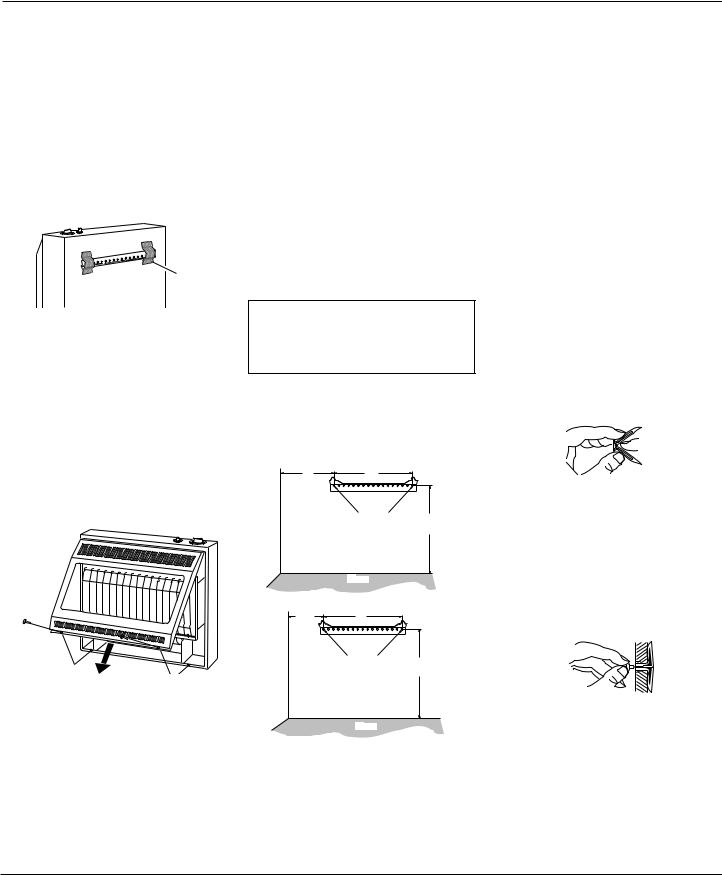
OWNER’S MANUAL
INSTALLING TO WALL
Continued
INSTALLING HEATER TO WALL
Mounting Bracket
The mounting bracket is located on back panel of heater. It has been taped there for shipping. Remove mounting bracket from back panel.
Mounting
Bracket
Figure 5 - Mounting Bracket Location
Removing Front Panel Of Heater
1.Remove two screws near bottom corners of front panel.
2.Lift straight up on grill guard until it stops. Grill guard will slide up about 1/4".
3.Pull bottom of front panel forward, then down.
4.Remove cardboard packing from grill and glass (CGN20[L]) or heat shield (RN30D).
Figure 6 - Removing Front Panel Of Heater
Methods For Attaching
Mounting Bracket To Wall
Only use last hole on each end of mounting bracket to attach bracket to wall. These two holes are 16 inches apart from their centers. Attach mounting bracket to wall in one of two ways.
1.Attaching to wall stud
2.Attaching to wall anchor
Attaching to wall stud: This method provides the strongest hold. Insert mounting screws through mounting bracket and into wall studs.
Attaching to wall anchor : This method allows you to attach mounting bracket to hollow walls (wall areas between studs) or to solid walls (concrete or masonry).
Decide which method better suits your needs. Either method will provide a secure hold for the mounting bracket.
Marking Screw Locations
1.Tape mounting bracket to wall where heater will be located. Make sure mounting bracket is level.
2.Mark screw locations on wall (see Figure 7).
 WARNING: Maintain minimum clearances shown in Figure 7. If you can, provide greater clearances from floor and joining wall.
WARNING: Maintain minimum clearances shown in Figure 7. If you can, provide greater clearances from floor and joining wall.
Note: Only mark last hole on each end of mounting bracket. Insert mounting screws through these holes only.
3.Remove tape and mounting bracket from wall.
11" |
16" |
Min. |
|
AdjoiningWall |
|
Only Insert Mounting |
32 1/2" |
||
|
|
Screws Through Last |
|||
|
|
Min. |
|||
|
|
Hole On Each End |
|
||
|
|
|
|
||
|
|
Floor |
|
|
|
|
|
RN30D |
|
|
|
|
7 1/4" |
16" |
|
|
|
|
Min. |
|
|
|
|
AdjoiningWall |
Only Insert Mounting |
18 3/4" |
|||
Screws Through Last |
|||||
|
Min. |
||||
|
|
Hole On Each End |
|
||
|
|
|
|
||
Floor
CGN20(L)
Figure 7 - Mounting Bracket Clearances
Attaching Mounting Bracket To Wall
Note: Wall anchors, mounting screws, and spacers are in hardware package. The hardware package is provided with heater.
Attaching to wall stud method
For attaching mounting bracket to wall studs
1.Drill holes at marked locations using 9/64" drill bit.
2.Place mounting bracket onto wall. Line up last hole on each end of bracket with holes drilled in wall.
3.Insert mounting screws through bracket and into wall studs.
4.Tighten screws until mounting bracket is firmly fastened to wall studs.
Attaching to wall anchor method
For attaching mounting bracket to hollow walls (wall areas between studs) or solid walls (concrete or masonry)
1.Drill holes at marked locations using 5/16" drill bit. For solid walls (concrete or masonry), drill at least 1" deep.
2.Fold wall anchor as shown in Figure 8.
Figure 8 - Folding Anchor
3.Insert wall anchor (wings first) into hole. Tap anchor flush to wall.
4.For thin walls (1/2" or less), insert red key into wall anchor. Push red key to “pop” open anchor wings.
IMPORTANT: Do not hammer key!
For thick walls (over 1/2" thick) or solid walls, do not pop open wings.
Figure 9 - Popping Open Anchor Wings
For Thin Walls
5.Place mounting bracket onto wall. Line up last hole on each end of bracket with wall anchors.
6.Insert mounting screws through bracket and into wall anchors.
7.Tighten screws until mounting bracket is firmly fastened to wall.
Continued
103568 |
7 |
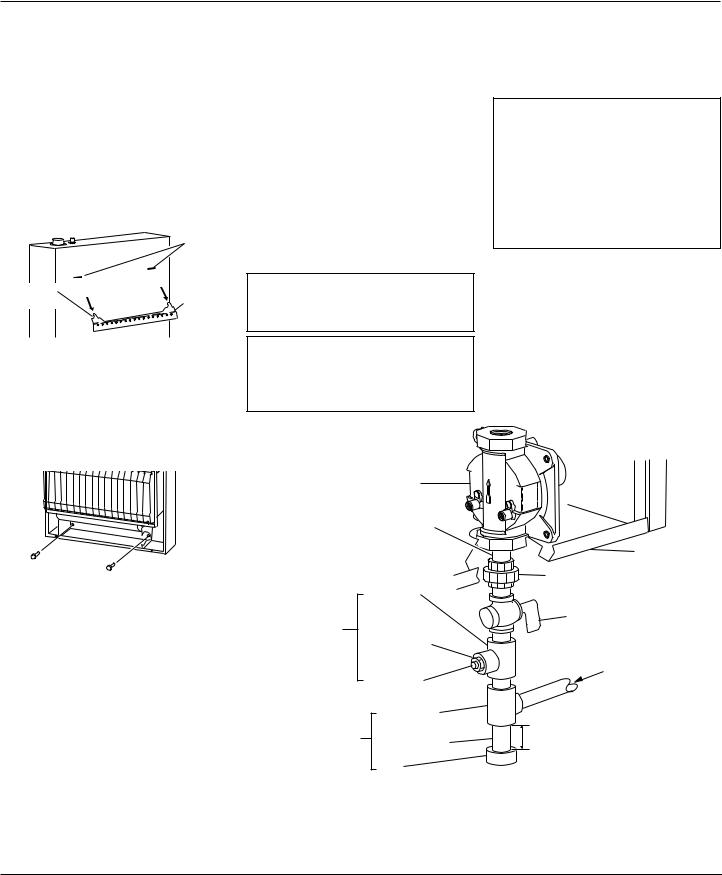
BLUE-FLAME CGN20, CGN20L AND RN30D
VENT-FREE NATURAL GAS HEATERS
INSTALLING TO WALL
Continued
Placing Heater On Mounting
Bracket
1.Locate two horizontal slots on back panel of heater.
2.Place heater onto mounting bracket. Slide horizontal slots onto stand-out tabs on mounting bracket.
|
Horizontal |
|
|
Slots |
|
|
Mounting |
|
|
Bracket |
|
Stand-Out |
(attached |
|
to wall) |
||
Tab |
||
|
Figure 10 - Mounting Heater Onto
Mounting Bracket
Installing Bottom Mounting
Screws
1.Locate two bottom mounting holes. These holes are near bottom on back
Figure 11 - Installing Bottom Mounting
Screws
panel of heater (see Figure 11).
2.Mark screw locations on wall.
3.Remove heater from mounting bracket.
4.If installing bottom mounting screws into hollow or solid wall, install wall anchors. Follow steps 1 through 4 under Attaching To Wall Anchor Method, page 7.
If installing bottom mounting screw into wall stud, drill holes at marked locations using 9/64" drill bit.
5.Replace heater onto mounting bracket.
6.Place spacers between bottom mounting holes and wall anchor or drilled hole.
7.Hold spacer in place with one hand. With other hand, insert mounting screw through bottom mounting hole and spacer. Place tip of screw in opening of wall anchor or drilled hole.
8.Tighten both screws until heater is firmly secured to wall. Do not over tighten.
Note: Do not replace front panel at this time. Replace front panel after making gas connections and checking for leaks (see pages 8-9).
CONNECTING TO GAS SUPPLY
NOTICE: A qualified service person must connect heater to gas supply. Follow all local codes.
 WARNING: Never connect heater to private (non-utility) gas wells. This gas is commonly known as wellhead gas.
WARNING: Never connect heater to private (non-utility) gas wells. This gas is commonly known as wellhead gas.
IMPORTANT: Check gas line pressure before connecting heater to gas line. Gas line pressure must be no greater than 14 inches of water. If gas line pressure is higher, heater regulator damage could occur.
 CAUTION: Use only new, black iron or steel pipe. Inter- nally-tinned copper tubing may be used in certain areas. Check your local codes. Use pipe of 1/2" diameter or greater to allow proper gas volume to heater. If pipe is too small, undue loss of pressure will occur.
CAUTION: Use only new, black iron or steel pipe. Inter- nally-tinned copper tubing may be used in certain areas. Check your local codes. Use pipe of 1/2" diameter or greater to allow proper gas volume to heater. If pipe is too small, undue loss of pressure will occur.
Typical Inlet Pipe Diameters
20,000 Btu/Hr models |
3/8" or greater |
30,000 Btu/Hr models |
1/2" or greater |
Installation must include a manual shutoff valve, union, and plugged 1/8" NPT tap. Locate NPT tap within reach for test gauge hook up. NPT tap must be upstream from heater (see Figure 12).
|
|
Note: Burner bracket |
|
|
not shown for clarity |
|
Pressure |
|
|
Regulator |
|
|
3/8" NPT |
|
|
Pipe Nipple |
|
|
|
Heater |
|
|
Cabinet |
|
|
Ground Joint |
|
Tee Joint |
Union |
|
|
|
Test |
Reducer |
Manual Shutoff |
Gauge |
Valve * |
|
Connection * |
Bushing to |
Typical Inlet |
|
1/8" NPT |
|
|
Pipe From |
|
|
|
|
|
1/8" NPT |
Gas Meter |
|
(4" W.C. to 10.5" |
|
|
Plug Tap |
|
|
W.C. |
|
|
|
|
|
Tee Joint |
Pressure) |
|
|
|
Sediment |
Pipe Nipple |
3" Minimum |
Trap |
|
|
|
Cap |
|
Figure 12 - Gas Connection
* An A.G.A. design certified manual shutoff valve with 1/8" NPT tap is an acceptable alternative to test gauge connection. Purchase the optional A.G.A. design certified manual shutoff valve from your dealer. See Accessories, page 15.
8 |
103568 |
